简单句、并列句和复合句
简单句、并列句和复合句
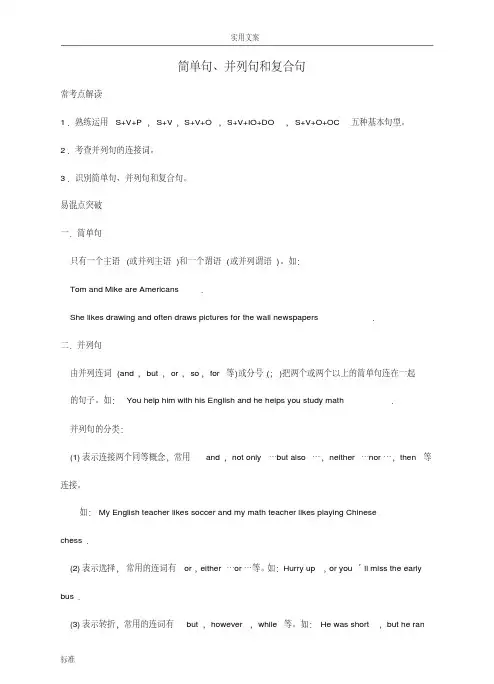
简单句、并列句和复合句常考点解读1.熟练运用S+V+P,S+V,S+V+O,S+V+IO+DO,S+V+O+OC五种基本句型。
2.考查并列句的连接词。
3.识别简单句、并列句和复合句。
易混点突破一.简单句只有一个主语(或并列主语)和一个谓语(或并列谓语)。
如:Tom and Mike are Americans.She likes drawing and often draws pictures for the wall newspapers.二.并列句由并列连词(and,but,or,so,for等)或分号(;)把两个或两个以上的简单句连在一起的句子。
如:You help him with his English and he helps you study math.并列句的分类:(1)表示连接两个同等概念,常用and,not only…but also…,neither…nor…,then等连接。
如:My English teacher likes soccer and my math teacher likes playing Chinesechess.(2)表示选择,常用的连词有or,either…or…等。
如:Hurry up,or you’ll miss the early bus.(3)表示转折,常用的连词有but,however,while等。
如:He was short,but he ranvery fast.(4)表示因果关系,常用的连词有so,for等。
如:He felt bad,so he didn’t go to schoolthis morning.三.复合句复合句指的是含有两个或更多的主谓结构的句子,其中有一个(或更多)主谓结构充当句子某一(些)成分,如主语、宾语、表语、定语、状语、同位语等,主语从句、宾语从句、表语从句、同位语从句、定语从句和状语从旬都属于复合句。
简单句,并列句,复合句
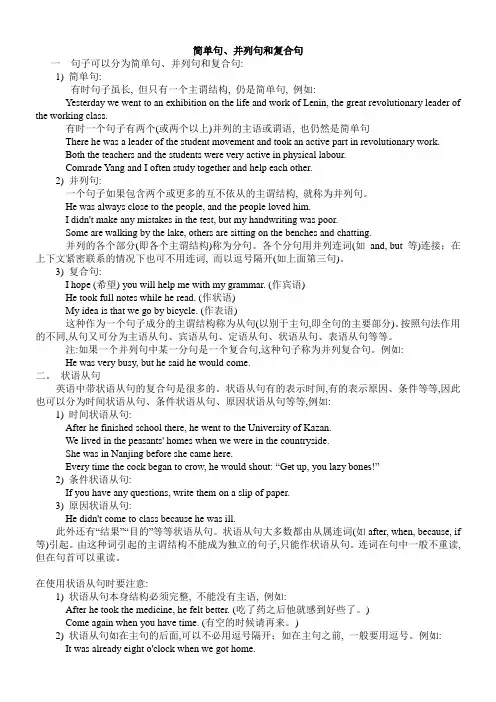
简单句、并列句和复合句一句子可以分为简单句、并列句和复合句:1) 简单句:有时句子虽长, 但只有一个主谓结构, 仍是简单句, 例如:Yesterday we went to an exhibition on the life and work of Lenin, the great revolutionary leader of the working class.有时一个句子有两个(或两个以上)并列的主语或谓语, 也仍然是简单句There he was a leader of the student movement and took an active part in revolutionary work.Both the teachers and the students were very active in physical labour.Comrade Yang and I often study together and help each other.2) 并列句:一个句子如果包含两个或更多的互不依从的主谓结构, 就称为并列句。
He was always close to the people, and the people loved him.I didn't make any mistakes in the test, but my handwriting was poor.Some are walking by the lake, others are sitting on the benches and chatting.并列的各个部分(即各个主谓结构)称为分句。
各个分句用并列连词(如and, but 等)连接;在上下文紧密联系的情况下也可不用连词, 而以逗号隔开(如上面第三句)。
3) 复合句:I hope (希望) you will help me with my grammar. (作宾语)He took full notes while he read. (作状语)My idea is that we go by bicycle. (作表语)这种作为一个句子成分的主谓结构称为从句(以别于主句,即全句的主要部分)。
简单句 并列句 复合句
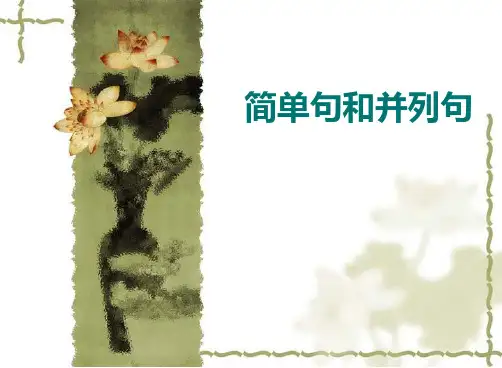
1. 陈述句(Declarative Sentences)
用来说明一个事实或陈述一种看法。例如: 1) Light travels faster than sound.
光比声传播速度快。(说明事实) 2) The film is rather boring.
这部电影很乏味。(说明看法)
要特别注意陈述句的否定结构
6. 状语 ( Adverbial )
常指修饰动词、形容词或副词的成分,修饰动词时 表示动作发生的时间、地点、目的或方式等;修饰 形容词或副词时表示它们的程度等。状语常由副词、 介词短语、动词不定式或分词短语等充当。 例如: 1. The miners work very hard. 2. She often helps Mike at school. 3. Hearing the news, he couldn’t help jumping.
3. 宾语 ( Object )
常指及物动词或介词后面使之意思完整的词或短语。 常由名词、代词、动词不定式或动名词短语等充当。 例如: 1. She has finished doing the experiment. 2. We like English and are good at it.
4. 表语 ( Predicative )
5)主 + 动 + 间宾 + 直宾 例如: My mother made me a new dress. 我母亲给我做了一件新衣裳。
IV. 并列句的常用连词
1. 我们常用并列连词and, not only…but also…等 连接联合并列句,用not only…but also… 时, 前面一句要用部分倒装 。例如: 1)Use your head, and you’ll find a way. 2)Not only does he want to come, but the students also need him.
简单句并列句复合句
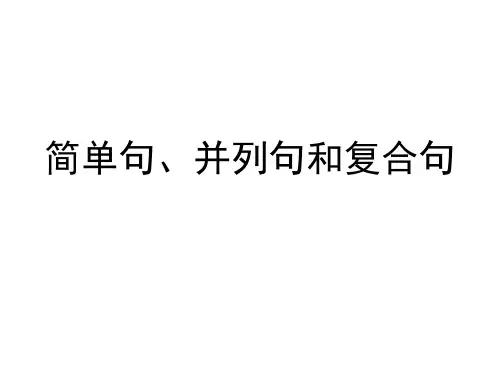
能连接并列复合句的副词
• besides 而且,还有 • hence 由此,因此 • nevertherless然而 • moreoever加之,因此 • otherwise 否则,要不然 • then 然后,于是 • therefore 因此,要不然 • then 然后,于是 • therefore因此,所以 • thus 因而,从而 • i am not feeling very well today, otherwise i would do
• 第四种句型: • 主语+动词+间接宾语+直接宾语 • 如:He brings me cookies every day. • They gave him a watch.
• 第五种句型: • 主语+动词+宾语+宾语补足语 • 如:He asked me to answer this question. • We often see him play basketball alone.
• 如:The old woman lives alone, but she never feels lonely.
• we love peace but we are not afraid of war.
第三种:表示选择关系
• 此类并列连词有or, otherwise, either…or…等。
• 第二种句型: • 主语+动词+宾语 • 如:He loves his wife.
• We will always remember the junior high school life.
• 第三种句型: • 主语+连系动词+表语 • 如:I am a winner. • The music sounds nice. • We are in the classmate.
简单句、并列句和复合句
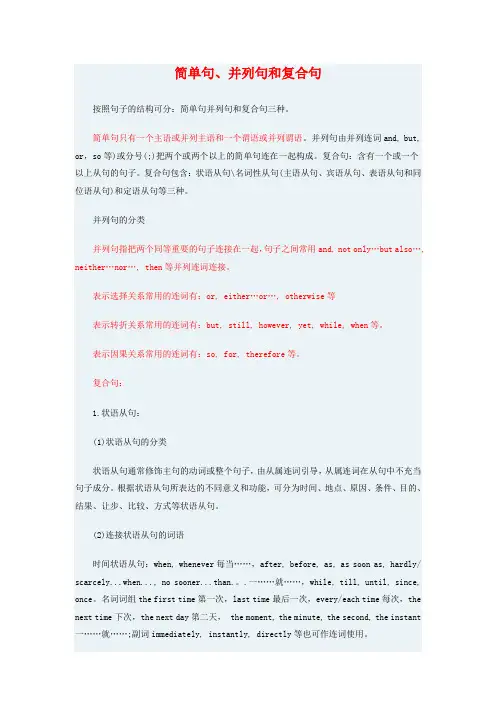
简单句、并列句和复合句按照句子的结构可分:简单句并列句和复合句三种。
简单句只有一个主语或并列主语和一个谓语或并列谓语。
并列句由并列连词and, but, or,so等)或分号(;)把两个或两个以上的简单句连在一起构成。
复合句:含有一个或一个以上从句的句子。
复合句包含:状语从句\名词性从句(主语从句、宾语从句、表语从句和同位语从句)和定语从句等三种。
并列句的分类并列句指把两个同等重要的句子连接在一起,句子之间常用and, not only…but also…, neither…nor…, then等并列连词连接。
表示选择关系常用的连词有:or, either…or…, otherwise等表示转折关系常用的连词有:but, still, however, yet, while, when等。
表示因果关系常用的连词有:so, for, therefore等。
复合句:1.状语从句:(1)状语从句的分类状语从句通常修饰主句的动词或整个句子,由从属连词引导,从属连词在从句中不充当句子成分。
根据状语从句所表达的不同意义和功能,可分为时间、地点、原因、条件、目的、结果、让步、比较、方式等状语从句。
(2)连接状语从句的词语时间状语从句:when, whenever每当……,after, before, as, as soon as, hardly/ scarcely...when..., no sooner...than.。
.一……就……,while, till, until, since, once。
名词词组the first time第一次,last time最后一次,every/each time每次,the next time下次,the next day第二天, the moment, the minute, the second, the instant 一……就……;副词immediately, instantly, directly等也可作连词使用。
高考复习-简单句-并列句和复合句

像上面这样,用从属连词连接两个简单句之后, 一个句子是主要的(主句),另外一个句子(从 句)是说明主要句子发生的时间、原因、条件等, 这样构成的句子称为复合句。
C.一个句子如果含有从句,如名词性从句(主语从句、
宾语从句、表语从句和同位语从句)、定语从句和状语 从句等,这个句子就是复合句。
定)语从句
I don’t know where he comes from.(
宾)语从句
Where he was born is not known yet.(
主)语从句
This place is where they once lived.(
表语)从句
考点5 一个句子有两个主谓结构时,要 考虑它们之间的连接问题
Dad on the farm.
并列句
考点4 引导的是什么从句,不仅要根据连词,还要根据句 子结构和句意来判别
说出下列复合句中,where引导的是什么从句。
You can find it where you left it.(
状)语从句
Tell me the address where he lives.(
His wife was ill, so/and he had to stay at home.
考点3 复合句
A. 用从属连词连接的句子是复合句。
还先两个错句: He likes English, his English is very good. × His wife was ill, he had to stay at home. ×
5.Both Tom and Jack enjoy country复m合u句sic.
简单句并列句复合句
The Simple, Compound and Complex Sentences简单句、并列句和复合句句子可以分为简单句、并列句和复合句几种形式,分别说明如下:1。
简单句只包含一个主谓结构的句子叫简单句。
如:We have learnt English for 3 years。
我们已经学英语3年了。
Her dream has become a reality.她的梦想成为了现实。
有时一个句子中有两个或两个以上的词担任主语或谓语,这个句子仍是简单句,只是这个简单句的主语或谓语由两个或两个以上的并列的词共同构成。
如:Mary, Mark and Jesse are all from USA。
(三个并列的名词担任主语)玛丽,马克和杰西都来自美国.These electrical appliances, meters and instruments are all good in quality. 这些电气设备,仪表和仪器的质量都很好。
The workers of the shipyard will dismantle the machine, clean its parts and reassemble it。
(三个并列的动词短语担任谓语)船厂的工人将拆卸该机器,清洁其部件,并重新组装.She has won many awards, and has even written a book about her experiences.她赢得了许多奖品并写了一本有关她的经验的书。
2. 并列句包含两个或两个以上的互不依从的主谓结构的句子叫做并列句.如:Our chief engineer ordered some spare parts and the shipchandler will deliver them on board this afternoon.我们轮机长订购了一些备件,今天下午供应商会把它们送到船上来。
英语句子分类之简单句,并列句和复合句
英语句子结构分类英语句子结构分类:简单句,并列句和复合句的概念及区别1. 简单句:无论句子长短,只包含一套主谓结构,句子中个个成分都是单词或短语。
有时主语或谓语可以是并列结构。
请划出下面句子的主谓宾成分。
The accident happened yesterday afternoon Our English teacher is thirty years old. He put the dictionary in the backpack.Grandma told me an interesting story last night. She kept the door open.My classmates and friends all received my Christmas cards and thanked me very much.and/but/or/so/however/for 等把两个或两个以上的简单句连接起来。
如: Come here and I ' ll help you. 请划出两个分句并判断各分句的成分。
并列连词:主要有 but (但是 ), yet (可是), while ( 而,却 )等 主要 or (或者,还是,否则 ), either, or (不是 、就是 ), neither, or,(既不、也不 ) otherwise (要不然 ) 主要有 and, not only, but also,( 不但 ,而且 ), when (=and just at this time 就在这时 )等。
主要有for (因为), so (因此 )等。
并列句例句:1. This is the custom of China. They are not like us to finish it in one drink, ___ b ut ____ prefer to drink by taking a smallamount at a time.2. My mother wants to decorate our rooms in a modem look__while ___ my father prefers a traditional style.3. It was time for her to have a new baby, ___and ___ i t was also time for the young panda to independent.4. He is a shy man , __but/yet _____ h e is not afraid of anything or anyone. 解析: But/yet 转折连词。
简单句并列句复合句
简单句并列句复合句简单句、并列句、复合句根据语法形式,即句子的结构,英语的句子可分为简单句、并列句和复合句。
1简单句句型:主语+谓语只包含一个主谓结构,而句子的各个结构都只由单词或短语表示They are playing baseball in the garden. 他们正在公园里打棒球。
Her brother and sister both are teachers. 她的哥哥和姐姐都是老师。
2并列句句型:简单句+并列连词+简单句(常见的并列连词有and,but,or)并列句是由两个或两个以上的简单句连接而成。
并列句中的各简单句意义同等重要,相互之间没有从属关系,是平行并列的关系。
它们之间用连词连结。
Her father is a doctor and her mother is a teacher.I liked the story very much but Li Ming wasn''t interested in it.Hurry up,or you''ll be late.3 复合句句型:主句+连词+从句;或连词+从句+主句(包含一个主句、一个或一个以上的从句,或只包含一个从句,但有两个或两个以上的主句的句子叫复合句。
)复合句(The Complex Sentence):句子中有一个或一个以上的从句,叫做复合句。
复合句可分为:1).定语从句(The Attributive Clause);2).状语从句(The Adverbial Clause);3).名词性从句(The Noun Clause):一、定语从句, 定语从句的定义定语从句在句子中作定语,用来修饰一个名词、名词词组或者代词。
, 先行词和引导词被修饰的名词、名词词组或代词叫做先行词;在先行词和定语从句之间起连接作用的词叫做引导词。
引导词分为“关系代词”和“关系副词”。
, 关系代词和关系副词关系代词有:who, whom, whose, that, which, as。
简单句、并列句和复合句的区别
简单句、并列句和复合句的区别在英语中,句子根据句子结构可以分为:简单句、并列句和复合句。
你知道要怎么区别简单句、并列句和复合句吗?接下来,店铺跟你分享简单句、并列句和复合句的区别方法。
如何区分简单句、并列句和复合句简单句、并列句和复合句的区别一、简单句当一个句子只包含一个主谓结构时,我们称之为简单句。
The train(主语) has just touched down(谓语).在英语中,最基本的句型大体上有五种。
1. S+Vi:主语+不及物动词She sat down beside me.2. S+V+P:主语+系动词+表语Mother isn't in at the moment.3. S+Vt+O:主语+及物动词+宾语I hope to finish the work today.4. S+Vt+OI+OD:主语+及物动词+间接宾语+直接宾语My uncle gave me a camera.5. S+Vt+O+C:主语+及物动词+宾语+宾语补足语The news made us sad.备注:S:主语Vi:不及物动词Vt:及物动词O:宾语OD:直接宾语OI:间接宾语C:宾语补足语二、并列句两个或两个以上独立的主谓结构或简单句并列在一起,我们称之为并列句。
各个简单句间是平行并列的关系,而非从属关系。
并列句的各个分句间可用逗号、分号、起连接作用的副词或并列连接词来连接。
1. 能连接并列句的连词and(和,又),but(但是),for(因为),however(然而),or(或者),so(所以,因而),while(然而),yet(然而)2. 能连接并列句的复合连词or else(否则,要不然),either...or...(要么···,要么···;或者···,或者···),neither...nor...(既不···,也不···),not only...but also(不仅···,而且···)3. 能连接并列句的副词besides(而且,还有),hence(因此),otherwise(否则,要不然),then(然后,于是),therefore(因此,所以),thus(因而,从而) 根据并列分句之间的不同关系,并列句则可以分为以下四种。
- 1、下载文档前请自行甄别文档内容的完整性,平台不提供额外的编辑、内容补充、找答案等附加服务。
- 2、"仅部分预览"的文档,不可在线预览部分如存在完整性等问题,可反馈申请退款(可完整预览的文档不适用该条件!)。
- 3、如文档侵犯您的权益,请联系客服反馈,我们会尽快为您处理(人工客服工作时间:9:00-18:30)。
简单句、并列句和复合句常考点解读1.熟练运用S+V+P,S+V,S+V+O,S+V+IO+DO,S+V+O+OC五种基本句型。
2.考查并列句的连接词。
3.识别简单句、并列句和复合句。
易混点突破一.简单句只有一个主语(或并列主语)和一个谓语(或并列谓语)。
如:Tom and Mike are Americans.She likes drawing and often draws pictures for the wall newspapers.二.并列句由并列连词(and,but,or,so,for等)或分号(;)把两个或两个以上的简单句连在一起的句子。
如:You help him with his English and he helps you study math.并列句的分类:(1)表示连接两个同等概念,常用and,not only…but also…,neither…nor…,then等连接。
如:My English teacher likes soccer and my math teacher likes playing Chinese chess.(2)表示选择,常用的连词有or,either…or…等。
如:Hurry up,or you’ll miss the early bus.(3)表示转折,常用的连词有but,however,while等。
如:He was short,but he ranvery fast.(4)表示因果关系,常用的连词有so,for等。
如:He felt bad,so he didn’t go to schoolthis morning.三.复合句复合句指的是含有两个或更多的主谓结构的句子,其中有一个(或更多)主谓结构充当句子某一(些)成分,如主语、宾语、表语、定语、状语、同位语等,主语从句、宾语从句、表语从句、同位语从句、定语从句和状语从旬都属于复合句。
(一)宾语从句:指在动词或介词后面用一个句子来担任宾语。
1.语序:宾语从句只有陈述语序(肯定句或否定句),即:主语在前,谓语动词在后。
如:He says(that)he likes reading a lot.Could you tell me when they will come?2.连接词1)当宾语从句是陈述句时,用that引导,that可省略。
如:She said(that)she could finish her work before supper.2)当宾语从句为特殊疑问句时。
用who,what.which,when,where,how,why,how many,how long等词引导。
不论是连接代词还是连接副词,后面都是接一陈述句。
如:Do you know when we’11 leave for Beijing?3)宾语从句是一般疑问句时,用whether或if引导。
如:I wondered if/whether you could come over to my house.Please let me know if/whether she likes the present.注意:在下列情况下只能用whether。
(a)在具有选择意义,又有or或or not时。
如:Let me know whether you will comeor not.(b)在介词后用whether。
如:I’m interested in whether he likes the book.(c)在不定式前用whether。
如:He hasn’t decided whether to visit her.3.主句和从句的时态,原则上宾语从句的时态应与主句的时态保持一致。
1)当主句是一般现在时时,宾语从句可根据实际情况使用任何时态。
如:I hear that a famous actor will sing in our hometown.2)当主句是过去时态时,宾语从句必须用过去时态的某种形式。
如:He wanted to know who the woman was.He was glad that he had passed the math test.3)当宾语从句表示的是一个客观事实或真理时,即使主句是过去时,从句也用一般现在时态。
如:The teacher told us that the earth goes around the sun.(二)状语从句:是一种作状语用的从句,修饰主句的动词、形容词、副词,或修饰全句。
①时间状语从句:常用while,when,as soon as,as,until,not…until,before,after,since等引导。
一般说来,时间状语从句中不用将来时,表示将来时间则需要用一般现在时来代替。
如:I didn’t tell him the news until the teacher came.Will they do it after they come here?②目的状语从句:常用so that,in order that引导。
如:He studied English day and night so that he could pass the exam.③地点状语从句:由where,wherever等连接词引导。
如:Where there is a will,there is a way.④条件状语从句:由if,unless等词来引导。
条件状语从句用来表示将来时间,用一般现在时,而主句用一般将来时。
如:If it doesn’t rain,we’ll go for a picnic.I’ll wait here Llnless you come.⑤让步状语从句:通常由although,though,however,whatever等引导。
如:Although I am poor,I am still very happy.⑥原因状语从旬:由as,because,since等词来引导,because从句一般位于主句后,since比as正式,其从句一般放句首。
如:He stayed at home because he didn’t like playing soccer.As(Since)you are not feeling well,you’d better stay at home.⑦比较状语从句:常由as…as,not so…as,more…than等来引导。
如:Chemistry isn’t so popular as English.⑧结果状语从句:由so,so…that,such…that等引导。
1)so…thatso+形容词/副词+that从句。
如:I am so excited that I can’t fall asleep.He draws so well that he will never give up.2)such…thatsuch+a/an+形容词+单数名词+that从句。
如:It is such an exciting moviethat1 want to watch it again.such+形容词+不可数名词或名词复数+ that从句。
如:It is such delicious food that We all like it very much.3)如果不可数名词或复数名词前有many,much,little,few修饰时,则用so…that。
如:They made so much noise that their mother got angry.(三)定语从句:在句中起定语作用,修饰句中的名词或代词的从句称为定语从句。
被修饰的名词或代词称为先行词。
定语从句由关系代词或关系副词引导。
①关系代词引导的定语从句的具体用法。
1)先行词指人或物时,关系词可用that,that在从句中作主语或宾语。
如:A plane is a machine that can fly.The woman(that)We Saw just now wasJim’s mother.2)先行词指物时,关系词也可用which,which在从句中作主语或宾语。
如:The school which is in front of the library is very beautiful.3)先行词指人时,关系词可用who和whom,who在定语从句中作主语或宾语。
作主语时,不能省略,作宾语时可省略;whom在定语从句中作宾语,可以省略。
如:The person(who/whom)you just talked to is Mr.Li.Mrs Read is the person to whom you should write.4)whose所有格指人,在定语从句中作定语。
如:I know the boy whose father works in a big hospital.5)以下几种情况必须用that引导定语从句。
先行词是不定代词something,nothing,anything等。
如:There is something that I want to do for you.先行词被序数词或形容词最高级所修饰。
如:This is the most terrible thing that I have met.先行词被the only,the very,the same,the last等修饰。
如:This is the only photo that I got from her.先行词既有人又有物。
如:They talked about persons and things that they met.(四)表语从句:放在连系动词之后,充当复合句中的表语。
①可接表语从句的连系动词有be,look,seem,sound,appear等。
②as,as if,though引导的表语从句。
如:It sounds as if someone is knocking atthe door.③because,why引导的表语从句。
如:That’s why he got angry with me.(五)同位语从句:用于对前面的名词做进一步的解释,说明名词的具体内容。
同位语从句一般由that引导,但也可以用whether以及连接代词和连接副词引导。
如:They were very worried about the fact that you were sick.在一些表示“建议,命令,要求”的名词后的同位语从句中,谓语动词用“should+动词原形”,should可省略。
